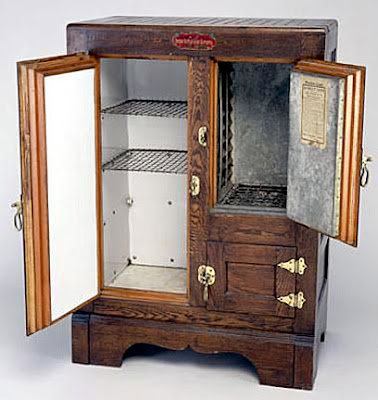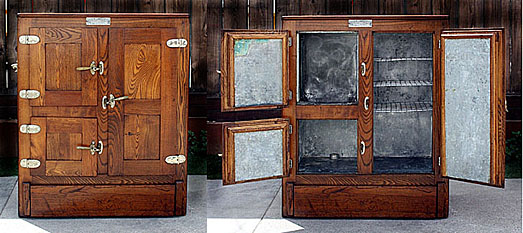 QUESTION: When I was a youngster, my family had an ice box in the kitchen. I remember when we first got it. My grandmother was in awe and my mother was overjoyed, for she could now keep food fresh for up to a week. Before that, she had to go to the grocers just about every day. Recently, I saw a beautifully restored old ice box at an antique show. Can you tell me who invented this food cold storage unit and when it first appeared in homes?
QUESTION: When I was a youngster, my family had an ice box in the kitchen. I remember when we first got it. My grandmother was in awe and my mother was overjoyed, for she could now keep food fresh for up to a week. Before that, she had to go to the grocers just about every day. Recently, I saw a beautifully restored old ice box at an antique show. Can you tell me who invented this food cold storage unit and when it first appeared in homes?
ANSWER: Before the mid 19th century, people depended on holes in the ground and spring houses to keep food cold. For the most part, people smoked meats and fish to keep them longer.
The traditional ice box dates back to the days of ice harvesting, which peaked between the 1850s and the 1930s, when manufacturers introduced the gas-powered refrigerator into American homes. However, the ice box became such a part of American culture that older people often refer to their refrigerators as ice boxes. But the real story of the ice box began in 1802.
 Back then, an American farmer and cabinetmaker, Thomas Moore, needed to figure out a way to get his butter to market in solid chunks rather than a melted mass. He experimented with various methods until he came up with an ingenious solution—the ice box. His first design consisted of an oval cedar tub with a tin container fitted inside with ice between them, all wrapped in rabbit fur to insulate the device. Later versions included hollow walls that were lined with tin or zinc and packed with various insulating materials such as cork, sawdust, straw or seaweed. He placed a large block of ice in a tray near the top, so cold air could circulate down and around the tin storage compartment. Moore used his device to transport butter from his home to the Georgetown markets, allowing him to sell firm, brick butter instead of soft, melted tubs like his fellow vendors.
Back then, an American farmer and cabinetmaker, Thomas Moore, needed to figure out a way to get his butter to market in solid chunks rather than a melted mass. He experimented with various methods until he came up with an ingenious solution—the ice box. His first design consisted of an oval cedar tub with a tin container fitted inside with ice between them, all wrapped in rabbit fur to insulate the device. Later versions included hollow walls that were lined with tin or zinc and packed with various insulating materials such as cork, sawdust, straw or seaweed. He placed a large block of ice in a tray near the top, so cold air could circulate down and around the tin storage compartment. Moore used his device to transport butter from his home to the Georgetown markets, allowing him to sell firm, brick butter instead of soft, melted tubs like his fellow vendors.
 By 1830, Moore refined his design by making a wooden cabinet, similar to a large dresser, of hardwoods such as oak or walnut. As with his earlier versions, he lined the cabinet with zinc or tin, packed with insulating materials such as straw, flax, sawdust, cork, mineral wool, or charcoal. He tried each material to see which worked best, eventually settling on zinc.
By 1830, Moore refined his design by making a wooden cabinet, similar to a large dresser, of hardwoods such as oak or walnut. As with his earlier versions, he lined the cabinet with zinc or tin, packed with insulating materials such as straw, flax, sawdust, cork, mineral wool, or charcoal. He tried each material to see which worked best, eventually settling on zinc.
Moore added several storage compartments inside the cabinet, with doors to each, including the ice compartment. He placed a drainage hole in it so that melted water, collected in a tray, could be emptied daily. Other ice box makers added spigots for draining the ice water.
The user had to replenish the melted ice, normally by obtaining new ice from an iceman, who delivered it by horse and wagon. The design of the ice box allowed perishable foods to be stored longer than before and without the need for lengthy preservation processes such as canning, drying, or smoking. Refrigerating perishables also had the added benefit of not altering the taste of what was preserved.
 Until the late 1820s, cabinetmakers made ice boxes to order. But by the 1840s, various companies appeared including Sears & Roebuck, The Baldwin Refrigerator Company, and the Ranney Refrigerator Company began to mass produce ice boxes. Historians consider D. Eddy & Son of Boston to be the first company to produce ice boxes in large quantities. During this time, many Americans desired big ice boxes. Such companies like the Boston Scientific Refrigerator Company, introduced ice boxes which could hold up to 50 lbs of ice. A survey of New York City residents in 1907 found that 81 percent of the families surveyed owned some form of ice box.
Until the late 1820s, cabinetmakers made ice boxes to order. But by the 1840s, various companies appeared including Sears & Roebuck, The Baldwin Refrigerator Company, and the Ranney Refrigerator Company began to mass produce ice boxes. Historians consider D. Eddy & Son of Boston to be the first company to produce ice boxes in large quantities. During this time, many Americans desired big ice boxes. Such companies like the Boston Scientific Refrigerator Company, introduced ice boxes which could hold up to 50 lbs of ice. A survey of New York City residents in 1907 found that 81 percent of the families surveyed owned some form of ice box.
Depending on the condition, an antique wooden ice box can be worth a lot of money. Many restored ice boxes now sell for as much as $2,000 to $3,000. It’s even possible to buy a restored antique wooden ice box that has been converted into a refrigerator or wine cooler with modern refrigeration equipment.
 The usability of an antique ice box determines its actual market value The ice box’s age, size, condition, material, authenticity and provenance all contribute to its value.
The usability of an antique ice box determines its actual market value The ice box’s age, size, condition, material, authenticity and provenance all contribute to its value.
Even a properly restored or professionally refinished ice box can be a good buy. While a restored or refinished model can sell for as little as $2,000, extremely rare ice boxes in good condition can cost as much as $10,000.
With those prices, it’s a good idea to make sure an ice box is worth it. Early ice boxes didn’t feature top-quality structure, so quality will vary. It’s important to check the wooden surface closely to detect signs of deterioration, such as visible cracks, chips, scratches, and warps. All of these add to the originality of the ice box. Reproductions are common, and many get sold as antiques.
To read more articles on antiques, please visit the Antiques Articles section of my Web site. And to stay up to the minute on antiques and collectibles, please join the over 30,000 readers by following my free online magazine, #TheAntiquesAlmanac. Learn more about "In the Good Ole Summertime" in the 2024 Summer Edition, online now. And to read daily posts about unique objects from the past and their histories, like the #Antiques and More Collection on Facebook.

